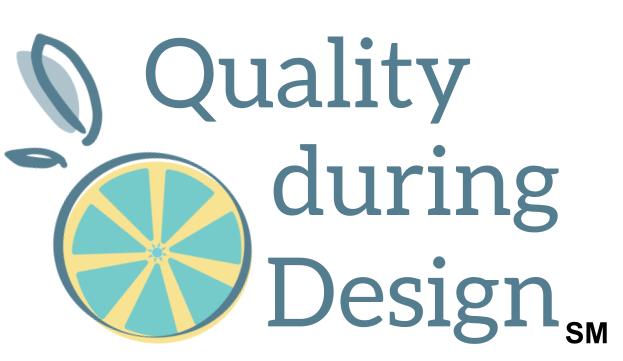Let's talk about cross-functional collaboration in product design, the challenges and how we can overcome some of those challenges and the reasons we would want to. Let's talk more about it after this brief introduction.
Hello and welcome to Quality During Design, the place to use quality thinking to create products others love for and less. Each week we talk about ways to use quality during design and product development. I'm your host, Dianna Deeney. I'm a senior level quality professional and engineer with over 20 years of experience in manufacturing and design. I consult with businesses and coach individuals on how to apply quality during design to their processes. Listen in and then join us. Visit QualityDuringDesigncom.
Cross-functional collaboration. First, let's talk about what a cross-functional team is. They are people that are assigned to a project to represent a certain function of the organization. They usually have decision-making capabilities when it comes to the project decisions and decisions about the product itself. Cross-functional team members may be representing the production and manufacturing facilities, marketing, reliability, quality and I would even consider project management as part of that cross-functional team. All of these different functions bring a different perspective of the project and the product when it comes to product development.
There are some challenges when working in a cross-functional team and I bet if you've been in product design, you've probably seen some of these challenges. For one, there's a perception that too many voices just get in the way of productivity. I just need to know what I need to know so that I can design something already and we can move on with the project. And there is something to say about just lolling in a project and not making progress on it. And if you have too many cooks in the kitchen, so to speak, that does make it more challenging.
Another challenge with cross-functional teams is how do you work together? A lot of times, teams get together and do brainstorming sessions, and I mean true brainstorming sessions. I think we've all had some bad experiences with brainstorming, but there is a place for it. When brainstorming was introduced about 50 years ago, it was the thing to do, it was easy to set up and a way for people to talk together. Also, during those 50 years, people experienced a lot of difficulty with getting productive brainstorming sessions or having results of a brainstorming session that they could actually use. And there were lots of studies done on brainstorming and how brainstorming groups work. Some of the quotes from some of the research is, there's no advantage to brainstorming group over a group of the same number of individuals working alone, or the brainstorming group came up with fewer ideas than the individuals, or just the quality and creativity of the ideas generated was actually lower. So some of our experiences with brainstorming may give us a negative viewpoint of cross-functional development.
The last challenge that I'll mention is sort of an obvious one: is conflicts. Whenever people are working together, there's going to be conflicts. From my experience and from other people's experiences, those challenges center around not being aligned with the same priorities, there's no end-to-end project leadership and not having a system that everyone worked within together. I'll link to some articles in the podcast blog about these kind of challenges.
So why do we even bother doing cross-functional product design or getting together with our cross-functional teams for product design? Because, despite its challenges, which we can overcome, there are a lot of benefits that we don't want to ignore.
For one, talking with people from different perspectives gives us a more complete picture, especially of the use space. Now, I'm a fan of cross-functional team collaboration, which is why I'm doing what I do. My main reason is that the different perspectives that each person brings from their respective areas of the business and also their independent individual experiences, helps create a more complete vision of a product and performance, both for the user and the risks it could introduce. People have studied this, too, involving multiple roles. For example, “Users and developers in the risk identification process will result in a more complete set of identified risks than if only one role is included in the process.”
Cross-functional collaboration also gives us clarity. Now, I've seen time and again the power of bringing people together to get a better understanding, greater alignment and improved designs, just to name a few of those benefits. With cross-functional collaboration, you're communicating, interacting and talking with other people, so you have that space and that opportunity to get clarity on what it is you're trying to do and your own goals and the goals of the greater project.
The last benefit of cross-functional collaboration that I'll talk about in this episode is that, as a product designer, you have lots of internal customers. You might be responsible for the design aspect and making decisions about how it's going to look, how it's going to be made and the materials that it's made from, but we all know that it takes a team of people to make a design idea a reality where someone is using and interacting with their product. In the field, product designers have many internal customers to their design contribution, meaning that the decisions that designers make affect many other people, including all of the people on the cross-functional team.
We know that team building, creation and management take skill and there's a lot of methods and techniques for managing that. But you may be thinking, “Dianna, I'm not managing a team. I'm not the one who decides who's on it. I'm assigned to a cross-functional team and I'm the product designer on the team.” Even still, we need to build something together with our cross-functional team.
I encourage you to facilitate meetings with a cross-functional team, so we need a way to work with our team on design decisions and design inputs. The challenge for product designers is in getting design inputs and their priorities based on things that matter. We're talking about product design concepts. At this point in our project, we've identified a need. There's a gap in the market, a potential new product, and we don't have anything developed yet. This is really when we need to get clear on design inputs before we start the designing process.
What we can do with our cross-functional team is to collaborate using directed co-work. We work toward a common goal, something that is not so big as the project goal, but something smaller and more focused that can be achievable within one working session.
And we want to focus on the user. We're designing and developing something for them, for them to be able to use it.
We'll have a starting point. We don't just show up with a cross-functional collaboration meeting with nothing. We do want to do some homework and not show up empty-handed.
And then have a roadmap to follow - a general direction that we're taking, the group prompted questions, scenarios within which groups can be creative...
We're really collecting our design inputs with our cross-functional team in a collaborative co-work meeting.
What I'm not talking about is I'm not talking about design sprints, whether the agile kind or the sprints product development kind, where you develop something in a week. I'm not talking about designing something together with a team. I am talking about exploring the use space and the concept space with our team for design inputs. The other thing I'm not talking about is I'm not talking about that typical brainstorming session that we mentioned earlier. There are elements of creativity and some brainstorming techniques, but it's within a structure. Having structured working meetings is much better than sharing reports where marketing creates a market needs analysis, writes it up in a report and then throws it over the wall to the engineering and design department.
Because our structured meetings are going to give us an opportunity to talk with and better understand the perspectives of our cross-functional teammates. That is going to give us easier buy-in on our design ideas that we're going to be making later, because we made them part of the design process. We're also going to avoid surprises because we've verified and checked and left room to explore interpretations and hidden problems in the use space, things that alone we wouldn't have noticed, but together we figured out.
As much as the members of our cross-functional team is part of the project, they do have their particular goals and they focus on their own particular part of the project or product. We just need to recognize that.
Our goal as a product designer is to give them opportunities to talk together and with us so that we can gather design inputs. And that's really what we want are the design inputs against which we can create a great design.
That may seem selfish that we're gathering our design inputs and identifying more opportunities for design options, but it really isn't selfish because the rest of the team is also getting the inputs they need. Manufacturing production is getting more information about what they may need for their manufacturing plan. Marketing is getting more clarity for their marketing plans. Reliability is gaining an understanding of some of the use space and use environment and limitations. Quality is getting an idea of what quality measures may be important for the user, and project management is getting an understanding of where there could be project risks.
As a product designer, it's really our responsibility to ask our cross-functional team for these inputs, because they are the internal customers or they represent our end users, which are our external customers.
So what's today's insight to action? If you approach collaboration in a structured way, with questions already formed and a way to communicate and facilitate your meeting so that you get the design inputs that you need, you're going to have more success with getting the design input that you need and you'll have a more successful design because of that.
Next week, we're going to be talking about leveraging proven frameworks for concept development, so we're going to be getting into some of these different frameworks and structured meetings that you'll be able to use in working with your cross-functional team.
At QualityDuringDesigncom, under training, there is a free lesson “Engineering Products from a Concept Space”. It's a video introduction to the use space and some of these frameworks that we'll be talking about next week. You get access to an online portal where you'll be able to log in time and again to view the video, read the transcript or get the downloads. I look forward to meeting you here next week. This has been a production of Deeney Enterprises. Thanks for listening.

